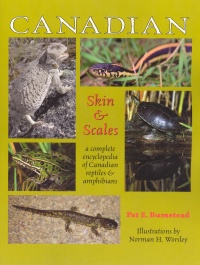| ________________
CM . . .
. Volume X Number 8. . . . December
12, 2003
excerpt:
This book is described as "a starting place to discover amphibians and reptiles." Among many books on reptiles and amphibians on the market, Canadian Skin & Scales is focused on those species especially adapted to live in the Canadian climate. You may actually see some of these creatures in your area, and you'll know which ones to look for after consulting the chart showing each province's resident animals. After believing for years that I was being serenaded on spring evenings in the prairies by the spring peeper, I've learned it was actually the Boreal Chorus Frog. The introduction defines the features that make certain ectothermic (you may be more familiar with the former term, 'cold-blooded') animals suited to the diverse climactic zones in Canada. The chapter, Amphibians, introduces two additional chapters on types of amphibians: Salamanders and Newts, Frogs and Toads. Reptiles are introduced in Chapter 5, followed by three additional chapters: Turtles and Tortoises, Lizards, Snakes. The final chapter lists and briefly explains environmental issues such as habitat loss, poaching, pollution and introduced species. Conservation programs are described, and the reader is referred to conservation organizations, websites of interest, internet and print resources. 'Words to Know' explains many biological terms used in the text. A detailed, five page index completes this resource. As the book moves from general information to specific, introductions to the amphibian and reptile classes compare and contrast the various characteristics of each group. Chapters on the Orders provide more specific detail. A general overview of habitat, features and family life is followed by a page of trivia (Stupendous Salamanders, Terrific Turtles). Each family group within the Order is then featured, eg. Sea Turtle Family section first shows typical family range, characteristics and reproduction, with a further page included for each species within that family. As a sample, particular facts about the Atlantic Ridley Sea Turtle include colour, reproduction, where they live and a point-form list of 'Did You Know....' data. Some pages have a Q/A feature, with the reader being directed to another page for the answer. Those animals designated 'in trouble' are given a symbol with reasons listed. Conservation is emphasized in the Foreword. A lot of information is packed into the 154 pages. Although the reading level of this book is quite accessible to middle grade students (grade 4 and up), the book may have limited appeal to young visual learners. While the species drawings are clear and detailed, the lack of coloured illustrations is one feature that may deter younger readers from turning to this resource first. Many frogs and salamanders are similar in size and shape, leaving colour clues the best way to distinguish them. A youngster trying to identify a species seen in the wild would first consult a field guide. At that point, this book will provide useful facts. However, the tight collection budgets elementary librarians face may compel them to select a single, full-colour volume that does both jobs. A second possible deterrent is the random arrangement of facts in the Did You Know... sections. Beginning research skills include locating facts under general subheadings (appearance, habitat, food, habits, etc) by using an index. However, the easiest access to the information in this index is through individual species names. This book will make a fine resource for older students or adults who want detailed facts on specific species. Recommended. Gillian Richardson, a freelance writer and former teacher-librarian, lives in Sorrento, BC.
To comment
on this title or this review, send mail to cm@umanitoba.ca.
Copyright © the Manitoba Library Association. Reproduction for personal
use is permitted only if this copyright notice is maintained. Any
other reproduction is prohibited without permission.
NEXT REVIEW |TABLE OF CONTENTS FOR THIS ISSUE
- December 12, 2003.
AUTHORS
| TITLES | MEDIA REVIEWS
| PROFILES
| BACK ISSUES
| SEARCH | CMARCHIVE
| HOME |
